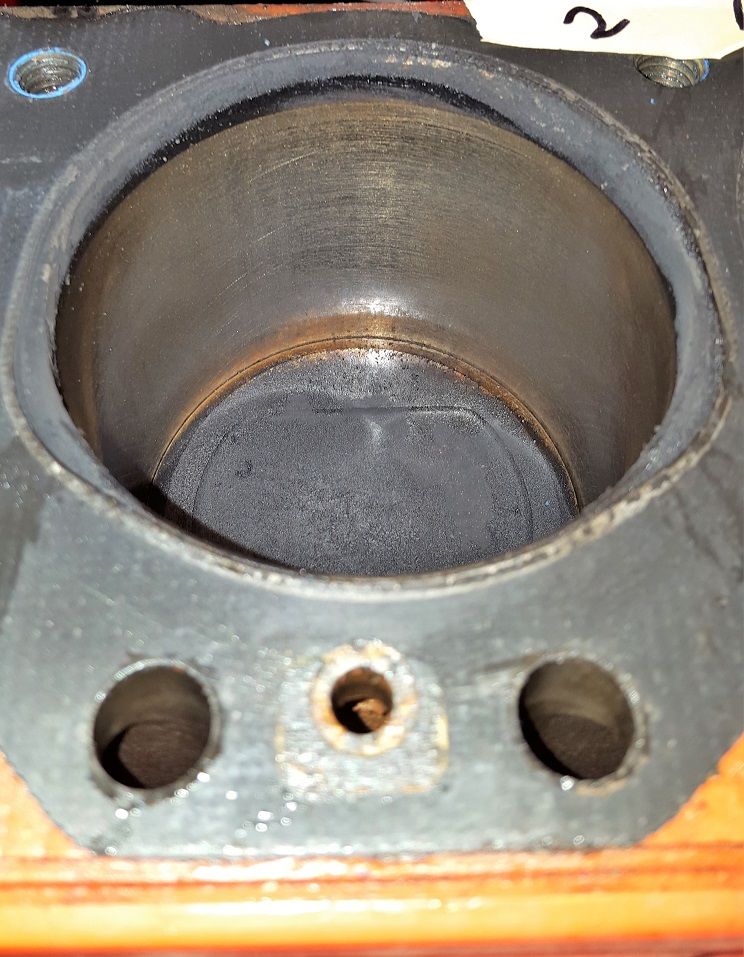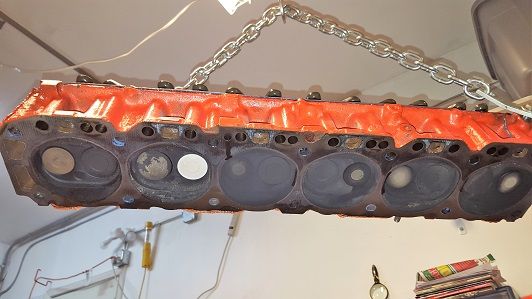Re: Forged Aluminum Pistons vs. Cast Iron
If all you're doing is regular street driving, the cast aluminum (they're not cast iron) are perfectly fine.
Kyvox, LOL, I mixed up that cast meant cast iron, not aluminum. Thanks for the correction.
Five is the one burning oil (that white residue on the exhaust valve is ash from he oil). Cylinder number four is running pig rich so I suspect your carb is leaking liquid gas into the manifold that flows directly into the number four cylinder. Three is also running rich with one and two also getting some oil fouling. You are complaining of low compression which when combined with oil contamination indicates to me bad ring sealing and oil control.
Just keep in mind most oil control issues with Chevy engines of this era were caused by valve guides oil slingers (rubber O-rings) getting dried out from excess heat turning brittle and then falling off. I always specified Studebaker Oil seals for the valves if I wasn't installing Perfect Circle Teflon plastic seals that required cutting the boss.
Check the block for cracks around the water pump and the head bolt holes because of the design it forces cold water against the number one cylinder and the underside of the deck of the block which caused stress in that area. This is the reason you have to be careful the engine stays cool. Back in the day your gas monkey at the pump would pop the radiator cap with a rag, then run away from the resulting geyser. After it stopped steaming he would then pour cold water back in the radiator to replace the coolant and rust that he had showered over your car. This caused more blocks to crack than I could count.
I used to sell six or seven 283 or 327 SBC along with 194/230/or 250 cid L-6 engines out of the back of my one ton truck to used car lots around town. I had previously gone down to Black Point in Tampa to pull rebuildable cores out of rail cars full of scrap iron from up and down the East Coast and out of the Mid-West (all bound for Japan via the Panama Canal). I bought the engines at current scrap metal prices tore them apart to see why they were in the scrap pile, did most of the machine work myself and then reassembled them with new rings and bearing on the cheap. What I couldn't use I traded back in the next week when I would pull out another eight to ten motors. Recycling at it's best.
I did this to support my drag racing habit. A friend of mine installed the motors I had dropped off and I bought the old motor at scrap metal prices the following week when I came around again to see if they needed another motor. They often said they wanted a SBF V8 or a Ford or Mopar six, but I stayed true to only working on Chevy engines. No one else picked up on this need apparently.
Big Dave
Big Dave, thanks for the critique, I spent last winter installing power disc brakes and power steering. Just got to the engine now.
I scraped off some gasket, didn't see any cracking, but my eye isn't trained and I didn't scrape everything off. I'll take this to the mechanic later this week.
The original carb had some backfiring and was drip, drip, dripping gas even after the rebuild, so I replaced it with Holley 390CFM (0-8007) and offy intake. Performance got better (old carb: 0-60 in 26 sec, holley: 20 sec, hah). Backfiring got worse, especially when cold. light touch and full throttle were OK, medium throttle backfire city. Advancing the timing to 20 BTDC (yes, 20 is right) reduced the backfire significantly (worse when cold). I put in HEI because I was going to anyways but zero difference. I thought maybe due to some sort of vacuum leak with a carb that was running leaner. I put on my new headers and exhaust to rule out a plugged muffler (it sure rattled a lot, though) with no change other than sounding really good. I then figured the problem was likely inside the engine somewhere and said enough with it, on to the 250 conversion. The new CAM gear has the dots aligned properly, which when installed wrong is an obscure oops sometimes made. The one valve looks like it was running hot to me.
On the carb, I didn't do anything with the jets at all. I couldn't find documentation saying what the jets are stock other than saying they're optimized for six cylinder and are nearly optimal in every application. I'll have to look it up and buy some smaller jets. Recommendations on how to choose the right size?
Thanks!!
Mark










